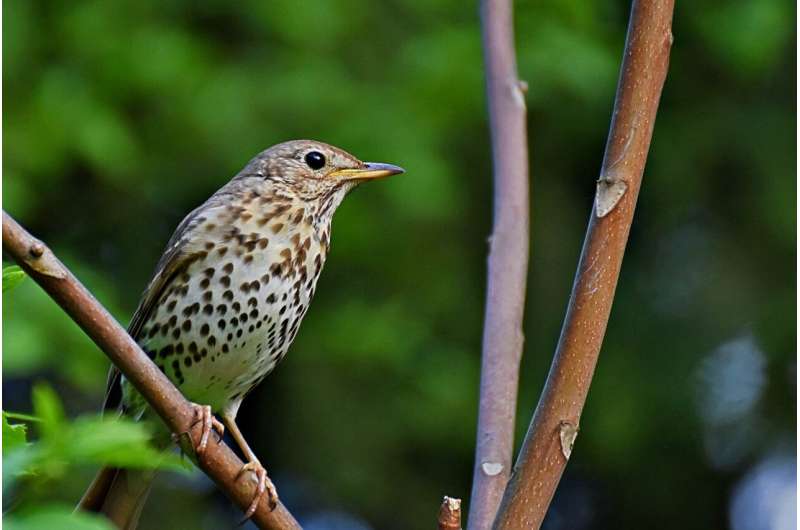Most European populations of the song thrush (Turdus philomelos) migrate only short distances and spend the winter in southwest France, the Iberian Peninsula, Italy, the Balkans, northern Africa, Asia Minor and the Near East. Populations breeding in Atlantic climates are partly resident. Credit: Simon Chinnery, Lizenz CC BY-SA 4.0
Each autumn, migratory birds in Europe set off on long and arduous journeys to spend the winter in the warmer south. They are not alone as around 20 percent of all bird species worldwide are migratory, moving between separate breeding and wintering sites each year. Some species migrate thousands of kilometers in just a few days or weeks whilst others will only travel short distances between breeding and wintering grounds. In contrast the majority of bird species do not migrate and remain in the same location year round. The question of why some birds migrate whilst others do not remains relatively unresolved.
Answers to this question are now provided by a new study under the direction of Dr. Alison Eyres. "We studied 437 passerine bird species from all over the world to understand why some birds migrate, and whether they do so to follow climatic conditions. To do this we classified species as migratory or sedentary and examined the range of climatic conditions they experienced throughout the year," explains Eyres, post-doctoral researcher at the German Senckenberg Biodiversity and Climate Research Center.
For migratory birds, it appears to be worthwhile to migrate instead of staying in place year-round, as this allows them to experience less climate variation. "Interestingly, however, this only applies to the outward flight. The return flight to the breeding areas is not beneficial for these bird species if one assumes that their goal is to live within their climatic preferences as much as possible," says the co-author of the study, Dr. Susanne Fritz, head of the Emmy-Noether junior research group at the German Senckenberg Biodiversity and Climate Research Center.
The authors conclude that climate is an important driver of migration to the winter range suggesting that birds are avoiding cold conditions. Eyres comments: "We find that climate is particularly important for migratory birds in temperate and arctic latitudes and less for migratory birds found in tropical latitudes, where the temperature fluctuates less during the year. However, migration to the breeding range was not driven by climate. Other factors such as availability of breeding places and food or avoidance of predators that may harm chicks are likely to be important here."
The fact that migratory birds do not migrate solely to follow climatic conditions is shown by a comparison with closely related resident birds, which was also part of the study. It shows that despite migrating long distances, migratory birds experience greater variability in climatic conditions than closely related resident species. This suggests that migration probably did not evolve to allow birds to track specific climatic conditions, but rather to utilize abundant food resources in the higher latitudes during breeding.
"Many recent studies have focused on understanding how climate change will impact migratory birds and their migration behavior. Our study shows that climate cannot be the only decisive driver of bird migration. In order to predict the future of migratory birds and to protect them, it is therefore also important to understand the impacts of habitat changes in the breeding areas. We should focus on protecting resource-rich habitats for birds, which are sadly already under strong threat from intensive land use and recent insect declines," Fritz concluded.
More information: Alison Eyres et al. A tale of two seasons: The link between seasonal migration and climatic niches in passerine birds, Ecology and Evolution (2020). DOI: 10.1002/ece3.6729
Journal information: Ecology and Evolution






















